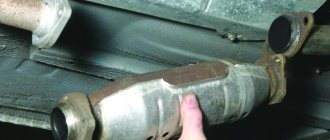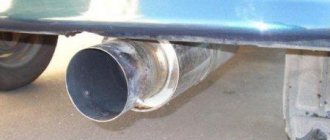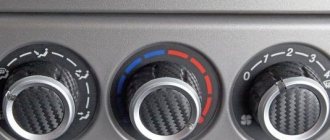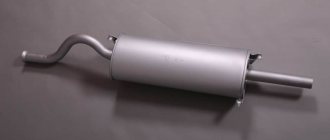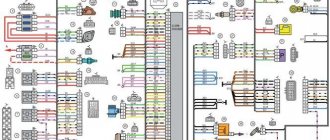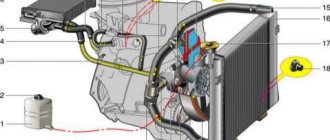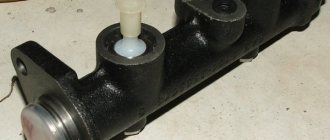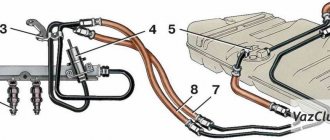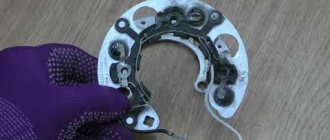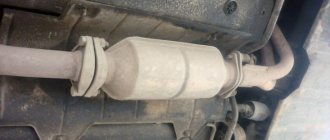Exhaust system VAZ 2107 injector diagram
The exhaust system consists of several parts, each of which plays an important role. These include the exhaust pipe, catalyst, resonator and the muffler itself. The main functions it performs are noise reduction and reduction in the emission of harmful gases. Also, there is often a corrugation on the receiving pipe, designed to reduce vibration. A malfunction of any part of the exhaust system can affect the condition of the entire car and many other parts in particular, so it is necessary to regularly diagnose this element of the car.
Major changes to components and assemblies
The matter was not limited to installing equipment for distributed injection on the VAZ 2107 car. The system, which ensures the exhaust of burnt gases, has also undergone serious modernization. A number of new elements have been added to it:
- A sensor was embedded in the exhaust manifold at the junction to determine the level of residual oxygen.
- A catalytic exhaust gas converter was installed under the bottom of the car in the central tunnel.
- This unit heats up to high temperatures during operation, and an additional steel screen was installed to protect the body and other parts.
- The resonator was shifted back in the direction of travel.
As a result, the exhaust system has become more complex, while reducing the toxicity of burnt gases. The injector allows you to regulate the specific amount of fuel in the mixture, reducing its consumption to a minimum.
Seven exhaust system design
The exhaust gas system of the VAZ 2107 is designed to perform a number of the following actions:
- The release of combustion products arising after combustion of the fuel mixture.
- Ventilation of the cylinders, which occurs during the emission of exhaust gases.
- Reduced noise levels.
- Heat removal.
The design under consideration includes the following elements of the exhaust system:
- The downpipe, which is better known as “pants”.
- Resonator.
- Muffler.
A downpipe is a device that connects directly to the exhaust manifold. From the exhaust pipe, the gases are immediately sent directly to the resonator, which is often called an auxiliary muffler. The resonator is designed to reduce noise levels and also extinguish fires coming out of the cylinders. The exhaust process ends with a muffler, which is designed to absorb the rest of the noise. However, it is almost impossible to make the motor operate completely silent.
In addition to the main components of the exhaust system, the diagram also includes:
- Muffler suspension mounting pad and rubber bands.
- Gaskets, which provide sealing and sealing of the connections of the constituent elements.
- The bolts of the clamps that secure the components.
The exhaust on the VAZ-2107 is realized due to the above elements, and the exhaust manifold is not an integral part of it, since it belongs to the engine.
Differences in carburetor and injection VAZ models
VAZ 2107 cars were produced in two types - carburetor and injection. They differ in fuel mixture injection systems. Differences in the injection system made some changes to the design of the exhaust system. The exhaust system of the VAZ 2107 carburetor models is described above. It differs from the VAZ 2107 injector system in the following ways:
- An oxygen sensor, which is designed to detect the composition of the mixture. It is located directly in the exhaust manifold.
- Neutralizer or catalyst. This device, which on injection models of the sevens, is located directly in front of the resonator. The neutralizer has a cylindrical design and is located in the central tunnel under the bottom.
These are the main additions that are present only on injection sevens. Due to the use of a catalyst in the design of the exhaust system, the resonator had to be moved closer to the rear.
The new exhaust system on the injection seven has become more complex in design, but due to the use of a catalyst, it was possible to reduce the level of exhaust toxicity. This made it possible to bring the exhaust system to the EURO-3 standard.
Repair of the exhaust system of VAZ 2107
Repair of the exhaust system on the VAZ 2107 is based on the replacement of component parts. Moreover, devices such as pants, a resonator or a muffler change. The reasons for the need for their repair are corrosion or burning of the metal. Internal parts corrode when exposed to moisture, which causes their destruction.
Moreover, there are two types of damage: both the internal components, which are presented in the form of meshes, and the outer walls of the component parts are damaged. It is not difficult to detect a breakdown and the need for repair. As soon as, after starting the engine, extraneous noise is detected coming from under the bottom, it is time to diagnose the system and identify the cause of the breakdown.
If the breakdown is due to a malfunction of internal parts, then the part must be replaced. If the cause of the noise is the appearance of holes in the body of the device - the resonator, muffler or pants, then you can try to eliminate them using a welding machine.
The VAZ 2107 resonator is replaced if it malfunctions. When replacing this device, it is important to consider the following recommendations:
- Replacement must be carried out only after the car has cooled down, since the exhaust pipe gets very hot when the engine is running.
- When removing the resonator, it is important to take into account such a factor as maintaining the device. After all, this part is not fixed, but is held in place by connecting to the pants and the muffler
If the muffler on a VAZ 2107 is faulty, then it also needs to be replaced. The replacement process is not difficult, however, this will require an inspection hole or overpass, from which the corresponding actions are carried out.
If the connecting pipes of the exhaust system elements in question are damaged, they can also be repaired, extending the service life to several thousand km. To eliminate such a breakdown, you will need to arm yourself with a special high-temperature sealant, as well as auxiliary tools and parts - metal scissors, soft metal for sealing, a metal brush to remove dirt, sandpaper and degreaser.
The repair process consists of performing the following tasks:
- Clean the rusted area.
- Cut a clamp that can be used to block the through holes.
- The rusted area must be degreased and then a sealant must be applied.
- Wrap the area with a piece of soft metal, and then place a tightening clamp on top.
- The most important thing when carrying out such repairs is the quality of sealing.
The nuances of muffler repair
Diagram of VAZ 21099 injector 8 valves engine diagram
The muffler of “classic” VAZ cars, according to the manufacturer’s recommendations, cannot be repaired. If a malfunction occurs in any element of the exhaust tract, the part must be replaced with a new one.
In fact, motorists often prefer to repair holes burned in the muffler - the most common defect - by welding.
The occurrence of “fistulas” is indicated by a change in the sound of the engine and the appearance of smoke from under the car. To troubleshoot, place the machine on a platform and inspect the elements of the exhaust system.
If the cause is a burnt gasket, remove the muffler and replace it. When you have an assistant, you can do without removing all elements of the system. Proceed in the following order:
- Unscrew the pipe fastening to the gearbox.
- Unscrew the nuts securing the exhaust pipe to the manifold.
- Together with an assistant, pull the “pants” off the pins while simultaneously rotating the bend of the resonator pipe.
- Replace the gasket, install the pipe in place, tighten the fasteners.
Replacing a burnt muffler gasket eliminates extraneous sounds from the engine
A welded muffler usually lasts less than a new one. But welding is also cheaper than buying. Usually, if it is necessary to repair a muffler by welding, they turn to professionals. If you have the equipment, you can do the work yourself. For this you will need:
- welding machine;
- blanks for patches made of sheet metal 1–2 mm thick;
- a piece of pipe of the same diameter as the failed one;
- grinder with cutting disc for metal;
- metal brush;
- sandpaper;
- heat-resistant paint for metal.
To repair the muffler, follow this sequence:
- Remove the muffler from the vehicle.
- Using an external inspection, determine the location of the malfunction and the extent of the damage.
- If there is a large hole in the muffler body, evaluate the condition of the internal parts. It is possible that repairing the external surface will not bring the desired restoration of the functions of the muffler without replacing the internals. In this case, it is advisable to contact professionals or simply replace the faulty part with a new one.
- Cut out the burnt area. From the blank, make a patch larger than the damage. Weld the patch over the hole with a continuous seam.
- If there is damage at the junction of the pipe and the muffler body, cut out the defective area, replace the damaged part of the pipe, and weld the repaired pipe to the muffler with a continuous seam.
- Clean the repaired muffler from dirt and rust, paint the part with two layers of heat-resistant paint.
Video: repairing a VAZ muffler by welding
Replacing and repairing a muffler is a dirty and time-consuming job. But there is nothing complicated about it. You never know what you can do till you try.
Home →
Maintenance and Repair →
Main advantages of the updated model
The modernized version of the VAZ 2107, which has an injector and an improved exhaust, has a number of advantages. The main advantages of the machine are as follows;
- The injector ensures high stability of engine parameters in different operating modes.
- The injection system increases specific power and torque, which adds dynamism to the car.
- During operation, the car's power unit produces less toxic emissions of CO and other compounds than its carburetor counterparts.
In practice, the operation of the machine is simplified for the driver; the injection system used is less demanding on the driver’s qualifications.
What is important to know about the resonator
Structurally, the pre-muffler is identical to the forward flow described above - a straight perforated pipe passes through the cylindrical body. The only difference is the partition that divides the tank space into 2 chambers.
The principle of operation of the element is based on the physical phenomenon of resonance - repeatedly reflecting from the partition and the inner walls of the can, sound waves cancel each other out.
The VAZ 2107 car is equipped with 3 types of resonators:
When operating resonators, the malfunctions described above occur - burnouts, rust and mechanical damage. Troubleshooting methods are similar to repairing a muffler - welding or temporary sealing with a bandage. Removing the resonator section is not difficult - you need to unscrew the fastening to the gearbox, then disconnect the muffler and “pants” pipes. On a VAZ 2107 with an injector, the flange is disconnected instead of the front clamp.
Replacing the muffler on a VAZ 2107 injector
Differences between the exhaust system of VAZ 2107 cars with injection engines:
- The exhaust pipe of the muffler already has a flange attaching it to the converter.
- The presence of a welded sleeve in the pants into which a lambda probe (oxygen concentration sensor) is installed.
- A catalytic converter with an iron carrier is installed in place of the additional front muffler.
- An additional muffler is installed, with a flange at the end of the front pipe.
- To compensate for bending loads when the engine oscillates, the converter flange is attached to the trouser flange pivotally, through a toroidal metal-graphite ring and spring-loaded bolts.
- The converter becomes very hot during engine operation; to protect the body from overheating and fire of the upholstery, a heat shield is located above the converter.
Replacing a VAZ 2107 muffler on an injection engine is not much different from replacing a muffler on a carburetor engine; if anything remains unclear to you, we recommend watching the video.
Instructions for replacing the resonator
Since the resonator on the VAZ 2107 is not attached to the body, it is necessary to hold it when replacing so as not to deform the exhaust pipe.
Resonator VAZ 2107
- Tap the pipe connections and clamps with a hammer, as in the previous case.
- First of all, we disconnect the resonator from the muffler, then from the “pants”. When connecting the resonator and the receiving pipe, we proceed according to the same scheme, bend the petals, use a “liquid key” or a grinder in the most extreme case, and very carefully.
- At the point where the resonator meets the muffler, the situation is more complicated. When the pipes have become stuck, we cut off a piece of pipe coming from the resonator, then remove the remaining part from the flare using a gas wrench or pliers. Usually in this place the pipes are stuck tightly, when it is impossible to separate them, we also change the muffler
- We install a new resonator, observing its original position. If the resonator is installed incorrectly, it will start knocking on the underbody or hitting uneven roads. It is desirable that the resonator pipe running from the receiving tube to the tank be parallel to the ground
- In the same way, we align the connection of the resonator with the silencer so that the tank is parallel to the ground and does not knock on the body
Changing the “pants” (reception pipe)
When replacing VAZ 2107 pants, be sure to stock up on a new gasket between the pants and the manifold, because it is destroyed when removed. It is also recommended to replace the nuts securing the pants to the manifold. So:
- First, disconnect the pants from the resonator. If problems arise, as in the case of the resonator, given the fact that the pants are replaced less often than other parts of the muffler, and the heating temperature of the connection during engine operation is quite high, we use an angle grinder.
Mounting for a carburetor engine. Nearby is the injector pants mount
- After removing the resonator, unscrew the four nuts securing the exhaust pipe to the manifold.
Unscrew the nuts securing the pants to the manifold, take out the gasket
- Be careful not to strip the studs to avoid unnecessary work replacing them. It is recommended to immediately treat them with a “liquid wrench”, otherwise we cut off the nuts using a grinder
- Working with a grinder, we cut the nut diagonally so as not to damage the thread of the stud. Then we simply knock it down using a chisel or flat screwdriver
- When installing the pants, replace the old gasket, then screw them to the exhaust manifold
- We connect the pants with the resonator and compress the flaring using a clamp.
If after replacement the exhaust system is raised under the bottom or sags:
- First, the receiving pipe and resonator are fixed at the wrong angle. We simply rotate the resonator and achieve the correct position of the system
- Second, the engine mount sagged. We change the engine mount.
Fasteners
Separately about fasteners - suspension pads and clamps. It is recommended to change them every time you change any part of the exhaust system. So:
- If the clamp looks like new at first glance, do not forget about metal fatigue. The thread “floats” over time, the clamp no longer holds the connection tightly, exhaust gases leak through and create additional noise. You will have to crawl under the car to change one clamp, and this, you see, is extra work.
- A simple inspection often fails to assess the level of wear on cushions and rubber belts. By installing old cushions with rubber belts in place, you risk losing the muffler as a result of their breakage. Considering that the price of a pillow or belt is much less than the price of a muffler, it is better to replace them immediately to avoid unnecessary costs.
Exhaust system design of VAZ 2107
Like most passenger cars, the VAZ 2107 has an exhaust system consisting of three main parts:
- a receiving pipe into which gases enter from the exhaust manifolds;
- VAZ 2107 resonator (additional muffler), where gases are directed from the exhaust pipe and where the exhaust sound is partially reduced;
- muffler, which absorbs most of the engine exhaust noise.
In addition to the above parts, the exhaust system includes:
- muffler mounting pad;
- pillow bolt;
- muffler suspension belt;
- clamp bolt and clamp securing the muffler to the resonator;
- clamp bolt and clamp securing the resonator to the exhaust pipe;
- clamp bolt and clamp securing the exhaust pipe to the body;
- nuts securing the exhaust pipe to the manifold;
- pad;
- locking plate;
Exhaust System Mounting Parts
The clamps and suspension elements of the exhaust system are exposed to moisture and salt during machine operation. In addition to corrosion, metal “fatigue” accumulates in clamps. The clamps begin to loosely hold the connection, as a result of which exhaust gases begin to break out, creating noise. Old suspension cushions may break off, which can damage exhaust system parts. Therefore, it is advisable to change the mounting parts; whenever large parts are replaced, the mounting elements on which they are attached should also be changed. This will avoid unnecessary problems and expenses.
Replacing the Muffler VAZ 2107 Injector
Muffler VAZ 2107 . how to replace it yourself
Clear understanding of the course of action during an event such as muffler replacement
VAZ
2107
, help every car owner complete the puzzle quickly and without errors. On the one hand, removing the old muffler and installing a new one seems easy, but on the other hand, you should be prepared for some difficulties.
Why and how often do I need to change the VAZ 2107 muffler?
The exhaust system of a car, despite its relatively simple design, performs many functions. The main ones are:
- removal of combustion products;
- significant reduction in exhaust noise levels;
- maintaining air balance with the intake system;
- ensuring effective cleaning and ventilation of cylinders.
Muffler VAZ 2107
You feel enormous stress like no other part of the car. First of all, metal causes constant temperature changes that actively destroy not only protective coatings, but also the structure of the metal itself.
What is a muffler for?
The exhaust system of any vehicle is based on the use of a special element called a muffler. Operating a car without a muffler is basically impossible.
The muffler is designed to perform two main tasks:
- reduce exhaust noise;
- transform the temperature and pulsation of the exhaust.
The rationale for using a muffler is explained by the fact that the exhaust gases, after exiting the engine cylinders, have very high pressure and temperature. At the same time, sound waves are launched ahead of the gases in the exhaust system, which can make very loud noise during the exhaust. The muffler converts sound waves into heat energy, thereby reducing the amount of noise created by the exhaust. However, all modern mufflers in some way affect engine performance, since the transformation creates counteraction, due to which engine power is reduced.
The end of the pipe should protrude no more than 5 cm beyond the car body
VAZ car mufflers use several different methodologies to reduce noise:
- expansion/constriction of gas flow;
- change in flow direction;
- sound wave interference;
- sound absorption.
Mufflers use multiple chambers of varying volumes to expand or narrow the flow of gas exhaust.
Muffler on VAZ classic
The entire exhaust system on domestic Zhiguli cars of the sixth and seventh models consists of three parts: the exhaust pipe, the main muffler and the resonator. Each of them performs its own function: the pipe extracts exhaust gases from the engine, the muffler converts gases and sounds, and the resonator reduces the noise level.
Traditionally, VAZ classics are equipped with mufflers manufactured by AvtoVAZAgregat. They are made of stainless steel with a thickened wall. Therefore, their service life can be considered durable. Silencers of more modern Zhiguli models can be considered alternative options, but not all of them are optimally suited to the “sixes” and “sevens”. However, craftsmen quickly remake the fastening elements and equalize the length of the mufflers in order to make them identical to the originals.
The modern muffler produced by AvtoVAZAgregat is an integral part of VAZ cars
Traditionally, the muffler on a VAZ classic is installed under the bottom of the car and is secured using bolted connections and special suspension rubber bands. The exhaust pipe exits from the rear of the body on the left side.
Muffler VAZ 2107 - how to replace it yourself
A clear understanding of the algorithm of actions when carrying out such an event as replacing a VAZ 2107 muffler will help every car enthusiast carry out his plans quickly and without errors. On the one hand, removing the old muffler and installing a new one seems simple, but on the other hand, you need to be prepared for some difficulties.
Why and how often is it necessary to change the VAZ 2107 muffler?
The exhaust system of a car, despite its relatively simple design, performs many functions. The main ones are:
- removal of fuel combustion products;
- significant reduction in exhaust sound level;
- maintaining air balance with the intake system;
- ensuring effective cleaning and ventilation of cylinders.
The VAZ 2107 muffler experiences enormous loads like no other part of the car. First of all, constant temperature changes have a destructive effect on the metal, which actively destroys not only the protective paint and varnish coatings, but also the structure of the metal itself.
Gases heated to a high temperature literally “eat up” the internal filling of the muffler, mixing with water condensate and oils, dissolving the metal walls, forming through corrosion. Externally, the muffler elements are also adversely affected by moisture, road sand and gravel; salt solutions in winter intensify the decomposition process.
As a result, after some time the driver can observe under the bottom of the car the pitiful remains of what was once called a muffler. Whether we like it or not, the muffler of a VAZ 21074 or any other model will have to be changed periodically. To the question of how often you should change the muffler, every car enthusiast must find the answer himself.
Exhaust system functions and parts replacement intervals
Despite its apparent simplicity, the exhaust system performs several important functions:
- removal of fuel combustion products;
- reduction of noise level from the exhaust;
- maintaining air balance in intake and exhaust systems;
- ensuring ventilation and cleaning of cylinders;
- reduction of CO content (in the presence of a catalyst).
Exposure to high temperatures, moisture, fuel and oil combustion products leads to through corrosion of exhaust system parts. This is aggravated by the external influence of gravel, sand and salt solutions that are used to treat roads in winter. Therefore, parts of the system have to be changed. The frequency of replacement depends on the following factors:
- car use activity;
- frequency of machine operation in bad weather (rain, snow);
- fuel quality;
- quality of exhaust system parts.
Recommendations for tuning
Problems with the exhaust system, admittedly, occur quite rarely. But sometimes drivers need tuning. When remaking this unit, do not forget about the need to reprogram the ECU. If changes have been made to the design, then you need to inform him about it. Otherwise, interruptions will occur and the injector may behave inappropriately.
Many car owners like to install devices that change the exhaust sound. This is where your imagination can run wild. A device for every taste. You can make the car quiet, or you can turn your horse into a sports car. It will roar like at a race. Mostly young guys love such tricks. This does not bring any benefit to the car. Only the owner’s “rating” increases in the eyes of some public.
Features of the injection model
At the same time, the VAZ 2107 model, in which an injector and the corresponding exhaust system are installed, has a number of disadvantages. The main one is that the vehicle's ground clearance has decreased significantly, resulting in a value of 7 cm. This circumstance primarily reduces the vehicle's cross-country ability not only off-road, but also on them. This should definitely be taken into account when traveling.
Another problem of the VAZ 2107 car is the low survivability of the exhaust system. The high temperature generated in the collector can cause dry grass or debris to catch fire. To avoid this development, the machine should be placed so that there are no plants or dry debris underneath it that could be ignited by the collector. The injector and exhaust circuit are turned off, which allows the temperature to decrease.
Over time, the exhaust system of the VAZ 2107 fails and the owner has to go to a service station or change it himself. In the latter case, you will need a standard tool and an inspection hole. You may also need a grinder and WD-40.
Types of products
You can buy the following types of mufflers for the domestic brand:
- assembly model “Izh-Auto”, which is suitable for VAZ 2104, 2106 and 2107;
- model for a sedan body, which is suitable, in addition to the VAZ 2107, on varieties 2101, 2103, 2105 and 2106.
The following types of exhaust systems are available on the market:
- stamped and welded. They involve stamping two metal parts of the product can, welding them and attaching them to the pipe. Initially, exhaust systems were made in this way, but then the more reliable rolling method replaced it;
Muffler for VAZ 2107 - stamped and welded
- sunset _ Involves wrapping sheet metal around the muffler. Despite the reliability of the method, factory parts are made only by the first method, so you can purchase roll-up exhaust systems separately.
Muffler for VAZ 2107 - sunset
Resonator malfunctions and repairs
Resonator failures include:
- pipe impacts on protruding parts of the body and other elements;
- burning out the end of the tank instead of welding the body and pipe;
- burnout of the body or internal perforated channel;
- removal of exhaust gases through fastening connections.
An irritating knock coming from underneath your car is usually caused by the exhaust pipe being knocked around by the body and other components. The reason for this is the rubber supports, which wear out and stretch over time and cannot provide rigid fixation of the exhaust section while driving. The problem is solved by replacing these supports.
Exhaust hangers usually last much shorter than the pipe itself. Check the condition of the rubber bands at intervals of 10 thousand km; if cracks are found, immediately install new suspension mounts.
Other problems can be solved in the following ways:
- The burn on the side of the resonator can be soldered. There is no need to pick up the phone to do this. An experienced welder will carry out the work on site, covering the body with asbestos foil.
- If you see exhaust gas leaking through the exhaust system joints, tighten the clamp or flange more securely. You can also loosen the fastener, connect the parts, and tighten the clamp again.
- If the internal housing or channel burns out, the resonator is usually replaced with a new one. If the fistula is small, you can try to prepare it without removing it from the car.
Car enthusiasts with welding experience can make a resonator tank with their own hands. To do this you need:
- Remove the resonator from the car.
- Carefully cut out the body with a grinder.
- Remove all dimensions (diameters of ducts and openings, dimensions of the housing).
- Make a new tank based on the measurements taken.
- Solder the old pipes to the new tank.
- Install a new resonator on the car.
Video: malfunctions of the exhaust system of classic VAZ models
When to change the resonator
The resonator of any car is an additional muffler that reduces the noise level of the engine. In addition to the main “can,” the resonator, or as it is also called, receiving pipe can be equipped with an additional one.
Ultimately, holes appear on the surface of the resonator, which disrupt its operation. Exhaust gases escape through these defects, creating an unpleasant sound of the engine, which is not only unpleasant to others, but will certainly not leave traffic inspectors indifferent. That is why a damaged resonator must be replaced immediately.
To change the resonator, you need to stock up on all the necessary keys, kerosene or WD-40, as well as a lot of patience and accuracy. The fact is that high temperatures cause the exhaust pipe fasteners to melt, which subsequently makes it difficult to remove. In addition, you will need an inspection hole or overpass, otherwise changing the resonator will be very inconvenient.
Many automotive technicians suggest applying sealant before installing the exhaust system. Whether to do it or not is up to you. In any case, the reliability of fastening and sealing the exhaust system is limited only by the force that the clamp allows you to make.
As some drivers joke, the muffler is one of those parts that “does not affect speed.” Indeed, getting to the garage without a muffler, if that happens, is acceptable. But everyday comfortable and safe operation of a car is impossible without this important design element.
How are knocking and muffler position related?
If the muffler suddenly starts knocking on some parts of the car, find the source of the extraneous sounds. Usually the reason lies in stretched rubber fasteners. After replacing them, the knocking will stop.
Sometimes a knock appears after work related to removing the muffler. In this case, extraneous sounds are a consequence of installation errors. Round pipes at the joints with clamps can be slightly rotated relative to the correct position: more or less than required, pushed into each other.
To eliminate knocking, restore the optimal position of the exhaust system elements.
Sagging mufflers can be “treated” using similar methods—by replacing rubber bands and correcting the position of joints.
